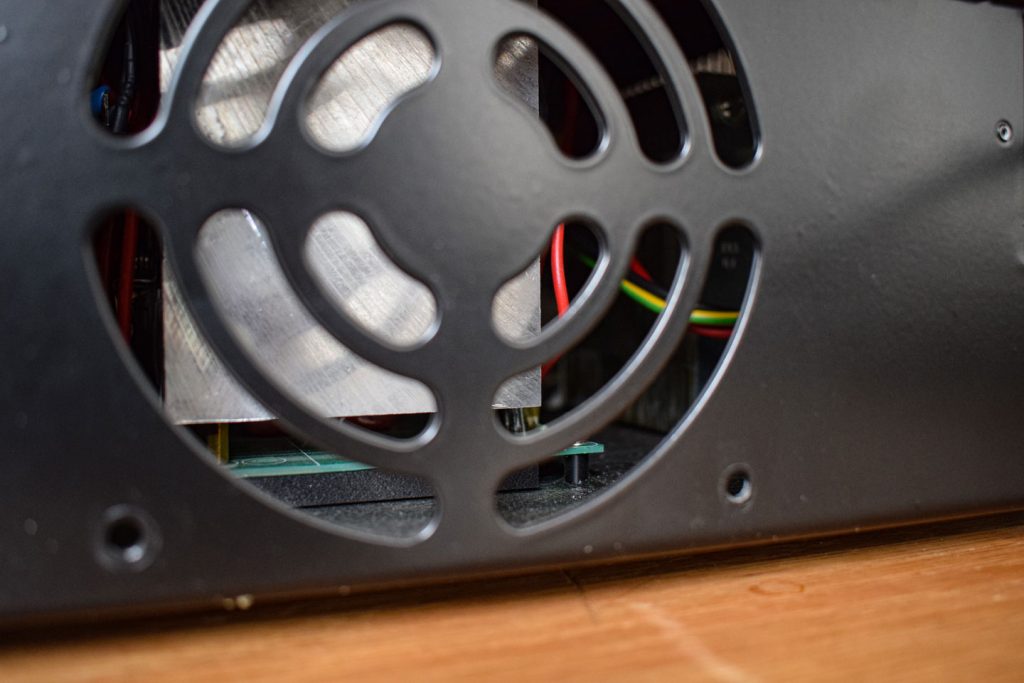We know Progressiv Audio as a manufacturer of outstanding sounding loudspeakers and amplifiers; PA boss Ralf Koenen simply knows what he is doing. But now he has looked outside the signal chain and, with the Progressive Audio Power Station 1KW, a power conditioner that is as clever as it is consistent (the name Power Conditioner is generally used), has got to the root of the problem of mediocre sound.
They do exist: Those rare moments that last much longer than is usually the case with a test. I recently had such a moment with the Musical Fidelity A1, for example, a Class A integrated amplifier that simply does things differently. Or with the Shunyata voltage derivation system, which has been an integral part of the reference chain ever since. And now with the Progressive Audio Power Station 1KW, which has made every colleague in the editorial team very thoughtful – which is why this source of pure electricity will now also become a permanent fixture in the listening room.

The background to the Progressive Audio Power Station 1KW
What is it all about? The situation is not new, but it is getting worse: because our power grid is becoming increasingly polluted with high-frequency waste due to cheap switching power supplies (from computers, LEDs and many other gadgets of the brave new world), but also due to photovoltaics, this inevitably also affects the sound of high-powered hi-fi components. Fluctuating voltages, which always occur when a particularly large number of loads are in operation at the same time, are another factor that degrades the sound. For the local electricity suppliers, a fluctuation range of 10% is still absolutely within tolerance. At 230 volts, however, this is already 23 volts, i.e. 207 volts in the worst case. However, I have also received letters from LowBeats readers who have measured voltages of less than 190 volts at times in their homes.
There is no need to worry about damaging the appliances. But anyone who has ever heard a good system with such a low power supply can confirm how tired and weak the sound can be. So if you’re wondering why your system sometimes sounds dynamic and sometimes sounds limp, you’ll most likely find the right answer in the voltage fluctuations of your power supplier. Another indication is temporary (and loud) transformer humming, which is usually also due to the voltage being too low.
There are plenty of mains filters against high frequency and DC interference on the market. At LowBeats, for example, we have been working with the Audes isolation transformer for a long time and are extremely satisfied with it because its filtering leaves the sound virtually undisturbed – which is by no means the case with all current filters.
But as good as the Audes is, it cannot compensate for the fluctuation in tension. Only so-called active power conditioners that actually ensure a stable voltage can do this. Dieter Burmester and Accuphase were early adopters of this in hi-fi. But of course the big names in power filtering – such as IsoTec, PS Audio & Co. – also have such power conditioners on offer. But the Progressive Audio concept seems to have been made even more consistent.

The structure
The housing is quite solid and made in the style of a large power amplifier: bulky, heavy and equipped with handles at the front and rear, which gives the whole thing a certain studio look. Galvanic isolation takes place after the mains input. The AC voltage is then rectified and the sine wave is regenerated in quasi-perfect form – i.e. without DC voltage components and with a distortion of less than 0.2%.
The Progressive Audio Power Station 1KW is almost indifferent to the input voltage: everything between 90 and 280 volts is converted to a load-stable 230 volts. A sinusoidal voltage with a constant amplitude is created, which does not buckle a bit even under pulse load up to the load limit. Of course, the connected hi-fi devices love it.

Progressive Audio boss Koenen has developed a high-precision and – as he says – very “hard” control for this. Very “hard” means that the control (a type of processor) switches off immediately at a deviation of just 2 mV. Koenen is also a developer of outstanding sounding amplifiers – so he has knowledge of and access to the fastest semiconductors, which also boast an ultra-steep characteristic curve. This is exactly what is used here. Koenen: “I not only attached great importance to maximum stability and minimum noise, but also made sure that the circuit virtually never clanks.”
There are eight equal sockets. They are fused with 16 amps and wired in a star configuration. All sockets are equipped with Furutech Rhodium NCF Schuko sockets. It doesn’t get much better than this.

At the front, everything is documented by clearly visible figures on the display. This is interesting, but after a while it becomes superfluous. Consequently, the display can be switched off using the toggle switch on the back.

Practice
There is not much to think about here. The Progressive Audio Powerstation 1KW is a relatively large device with the dimensions (and weight) of a substantial power amplifier. Ideally, the good piece operates invisibly in the background. But because it is completely fanless and quiet, the Power Station 1KW can also be used in the listening room.

The eight mains sockets are all equally authorized – none are specially filtered or intended for particularly power-hungry components. It’s also nice that the concept makes the user independent of the potential and that phase relationships don’t play a role. This means that it simply doesn’t matter which way round you insert the plug into the socket. Great for all those who are not so familiar with it and don’t feel like using a phase tester.

Koenen recommends docking all devices in a playback chain to the Power Station – that basically goes without saying. But Koenen also describes a point where sound degradation could creep in through the back door. Namely, when devices with protective conductor potential are connected via detours. Koenen: “This happens quickly via the streamer, which is connected to a router via LAN – and this in turn via the TAE socket with grid potential from Telekom.” Progressive Audio offers a high-speed LAN isolator as an accessory for the Power Station specifically for this case.
The name suffix 1KW refers to the power of the Power Station: The test model therefore had up to 1,000 watts available. That is a lot and could not be fully utilized with our reference system. If it does, the Power Station switches off rigorously at the slightest overload. You must then briefly press the on/off switch. For systems with particularly high power consumption, Koenen therefore also offers the 3KW version with a corresponding 3,000 watts. The good piece is slightly heavier with the same dimensions and around 4,000 euros more expensive. During my visit to Progressive Audio Manufaktur, I had the opportunity to listen to both against each other. But there was zero difference – they sound 100% the same.
Listening impression
It may be that the city grid in Munich is under particular strain and the grid fluctuations are unduly high. But I don’t think so, especially as we’ve been using the Power Station for many weeks now and have heard it “with” and “without” from time to time: The changes were always very similar. So we will have the usual urban conditions in our listening rooms. And under these conditions, great things happen with the Power Station. I can’t remember a time when the addition of a component has brought about such an improvement in the sound of our reference chain.
After the first few minutes of music, everyone present was amazed at how much more accurate the sound became with the Power Station. At first no one spoke, then everyone spoke in confusion: “That’s not possible.”
Yes, it is. First of all, this enormous gain in fine dynamics. Suddenly there was a lot more drive, especially in percussive recordings. As if all the handbrakes had been released, everything seemed more open, finer, somehow “freer”. The resonance of the heads, the direct impulse when the bass drum is kicked – everything was much more precise, gripping and “right”.

This impressive form of more accurate reproduction was of course also reflected in the more precise imaging: in such recordings, you could almost feel the artist, the instrument.
What fascinated me most, however, was the even better depth imaging. I have to say that our reference chain (Canor Hyperion pre/end combination and FinkTeam Borg loudspeakers) already has a stunning spatiality and depth. I often like to use the recording “Borderland” by Anne Clarke for listening tests – precisely because it is recorded with such intense spatiality. Accordingly, our reference chain transports the listener right into the depths of the recording room. That is quite impressive. But with the interposition of the Power Station, another 2-3 layers were added at depth. I would never have guessed that before the test.

And unlike many classic mains filters, the Power Station does not change the sound, but simply makes it significantly better in many aspects of reproduction: the right medicine without after-effects – if you ignore the price…
Conclusion Progressive Audio Power Station 1KW
Rarely has the use of a component shown us how great the influence of the domestic power supply and its stable (or fluctuating) voltage is on the sound of the system. It may be that there are better voltage conditions in the countryside. But contamination of the electricity grid is also increasing there.
In all LowBeats listening rooms, the difference was greater than expected. The Power Station is not a special offer, but it is the right answer for all those who expect their high-quality (and probably expensive) system to play absolutely on point at all times – with an increase in cleanliness and three-dimensionality that is astonishing. My tip: postpone buying an even better amplifier or loudspeaker and try a Power Station instead. You may already have reached your destination by then.
RATING
Sound gainUsabilityBuild QualitySummary |
| The rating always refers to the respective price category. |
| | Usually provides significantly more detail and depth |
| | Ensures absolutely stable current/voltage conditions |
| | Potential-free isolation, easy-to-read display that can be switched off |
| | Not expensive in view of the sonic result |
Distribution:
Progressive Audio Distribution
August-Thyssen-Str. 13a
45219 Essen, Germany
www.progressivaudio-essen.de
Pair price (manufacturer’s recommendation):
Progressive Audio Power Station 1KW: 10,000 euros
Progressive Audio Power Station 3KW: 14,000 euros
Technical data
| Progressive Audio Power Station 1KW | |
|---|---|
| Concept: | Active power conditioner |
| Maximum performance: | 1,000 watts |
| Slots: | 8 x NCF, fuse protection 16 amps |
| Structure: | Star-shaped, potential-free separation |
| Special feature: | Fanless cooling concept |
| Housing: | Black lacquered metal |
| Dimensions (W x H x D): | 50.0 x 24.0 x 42.0 cm |
| Weight: | 30.5 kilos |
| All technical data | |




